Analysis of Costing Methods: SMEs Responsibilities and ABC vs TCA
VerifiedAdded on 2023/06/08
|34
|10544
|472
Report
AI Summary
This report examines the responsibilities of small to medium-sized enterprises (SMEs) in relation to costing mechanisms, specifically comparing activity-based costing (ABC) and traditional cost accounting (TCA). It explores the effectiveness of TCA for SMEs, highlighting its simplicity and ease of understanding, especially when overhead costs are low. The report also investigates the efficacy of ABC for SMEs, noting its accuracy in presenting product costs by focusing on cause-and-effect relationships. Benefits of ABC include better cost control, improved decision-making, and enhanced tracking of overheads. However, limitations include high implementation costs, potential misinterpretation of data, and non-adherence to standard regulations. The report emphasizes that ABC is most effective when numerous overheads and diverse products exist, while TCA is suitable for businesses with low overhead and limited product lines. Ultimately, the research aims to provide insights into the strategic advantages and disadvantages of both costing methods for SMEs.
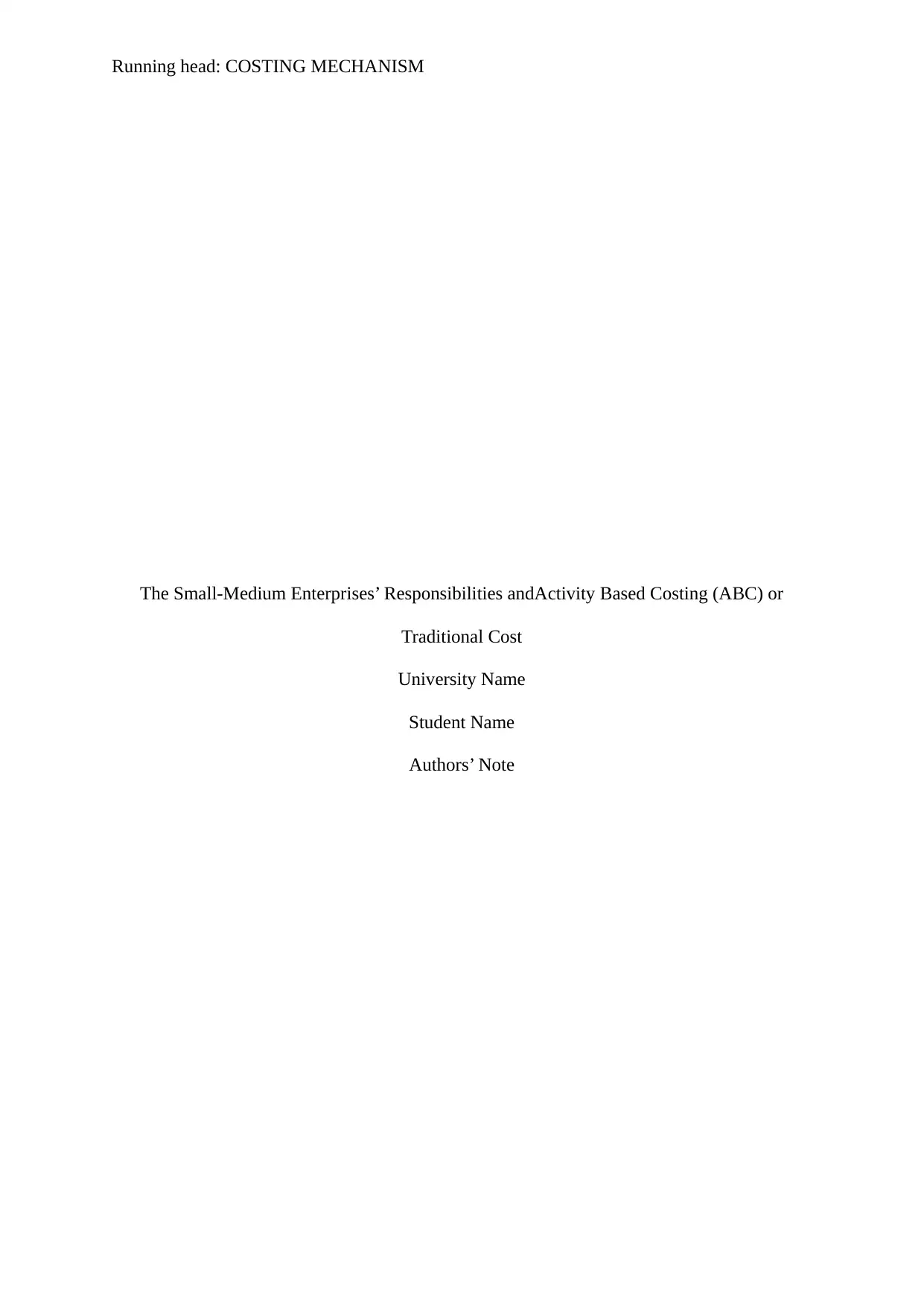
Running head: COSTING MECHANISM
The Small-Medium Enterprises’ Responsibilities andActivity Based Costing (ABC) or
Traditional Cost
University Name
Student Name
Authors’ Note
The Small-Medium Enterprises’ Responsibilities andActivity Based Costing (ABC) or
Traditional Cost
University Name
Student Name
Authors’ Note
Paraphrase This Document
Need a fresh take? Get an instant paraphrase of this document with our AI Paraphraser
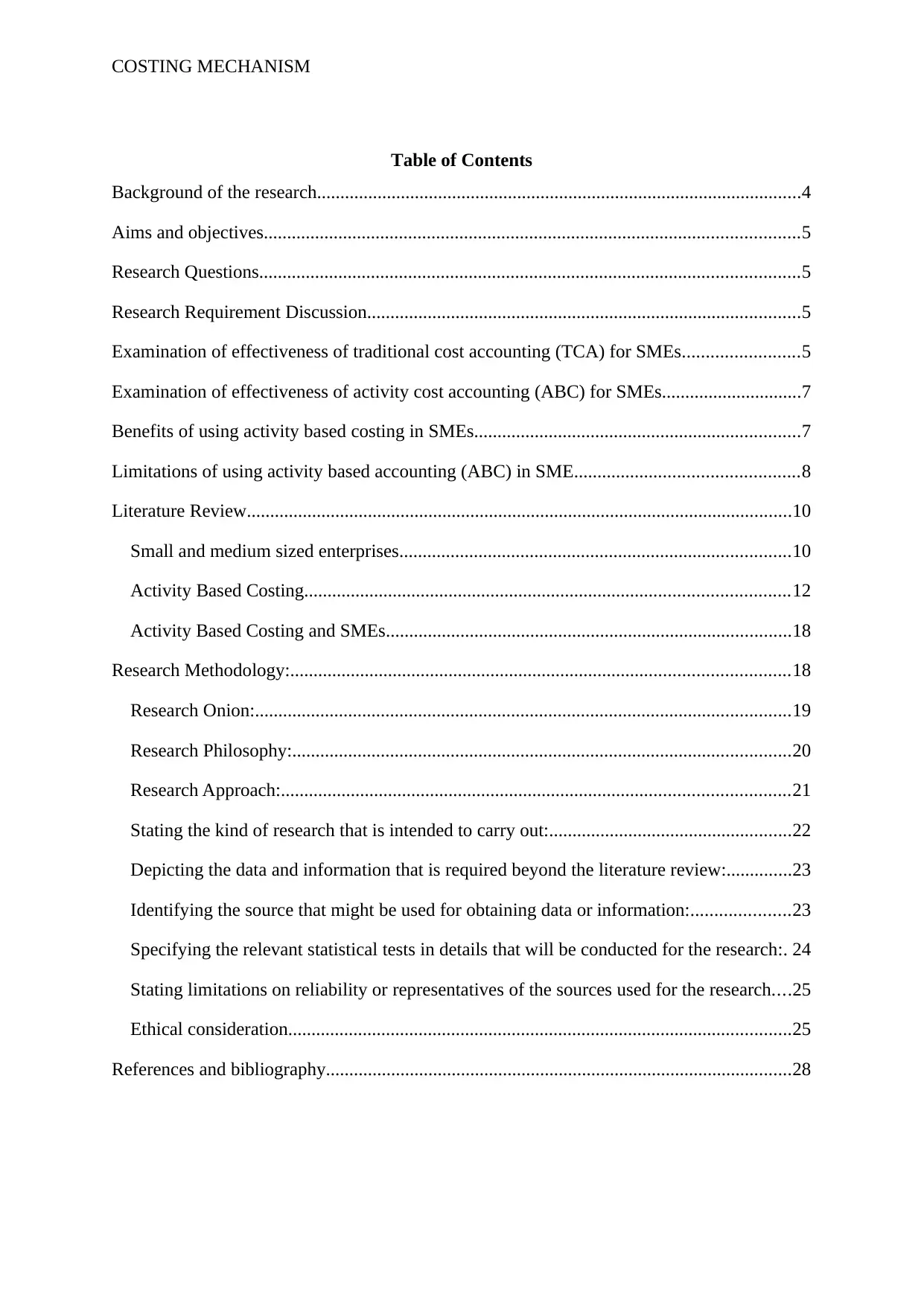
COSTING MECHANISM
Table of Contents
Background of the research........................................................................................................4
Aims and objectives...................................................................................................................5
Research Questions....................................................................................................................5
Research Requirement Discussion.............................................................................................5
Examination of effectiveness of traditional cost accounting (TCA) for SMEs.........................5
Examination of effectiveness of activity cost accounting (ABC) for SMEs..............................7
Benefits of using activity based costing in SMEs......................................................................7
Limitations of using activity based accounting (ABC) in SME................................................8
Literature Review.....................................................................................................................10
Small and medium sized enterprises....................................................................................10
Activity Based Costing........................................................................................................12
Activity Based Costing and SMEs.......................................................................................18
Research Methodology:...........................................................................................................18
Research Onion:...................................................................................................................19
Research Philosophy:...........................................................................................................20
Research Approach:.............................................................................................................21
Stating the kind of research that is intended to carry out:....................................................22
Depicting the data and information that is required beyond the literature review:..............23
Identifying the source that might be used for obtaining data or information:.....................23
Specifying the relevant statistical tests in details that will be conducted for the research:. 24
Stating limitations on reliability or representatives of the sources used for the research....25
Ethical consideration............................................................................................................25
References and bibliography....................................................................................................28
Table of Contents
Background of the research........................................................................................................4
Aims and objectives...................................................................................................................5
Research Questions....................................................................................................................5
Research Requirement Discussion.............................................................................................5
Examination of effectiveness of traditional cost accounting (TCA) for SMEs.........................5
Examination of effectiveness of activity cost accounting (ABC) for SMEs..............................7
Benefits of using activity based costing in SMEs......................................................................7
Limitations of using activity based accounting (ABC) in SME................................................8
Literature Review.....................................................................................................................10
Small and medium sized enterprises....................................................................................10
Activity Based Costing........................................................................................................12
Activity Based Costing and SMEs.......................................................................................18
Research Methodology:...........................................................................................................18
Research Onion:...................................................................................................................19
Research Philosophy:...........................................................................................................20
Research Approach:.............................................................................................................21
Stating the kind of research that is intended to carry out:....................................................22
Depicting the data and information that is required beyond the literature review:..............23
Identifying the source that might be used for obtaining data or information:.....................23
Specifying the relevant statistical tests in details that will be conducted for the research:. 24
Stating limitations on reliability or representatives of the sources used for the research....25
Ethical consideration............................................................................................................25
References and bibliography....................................................................................................28
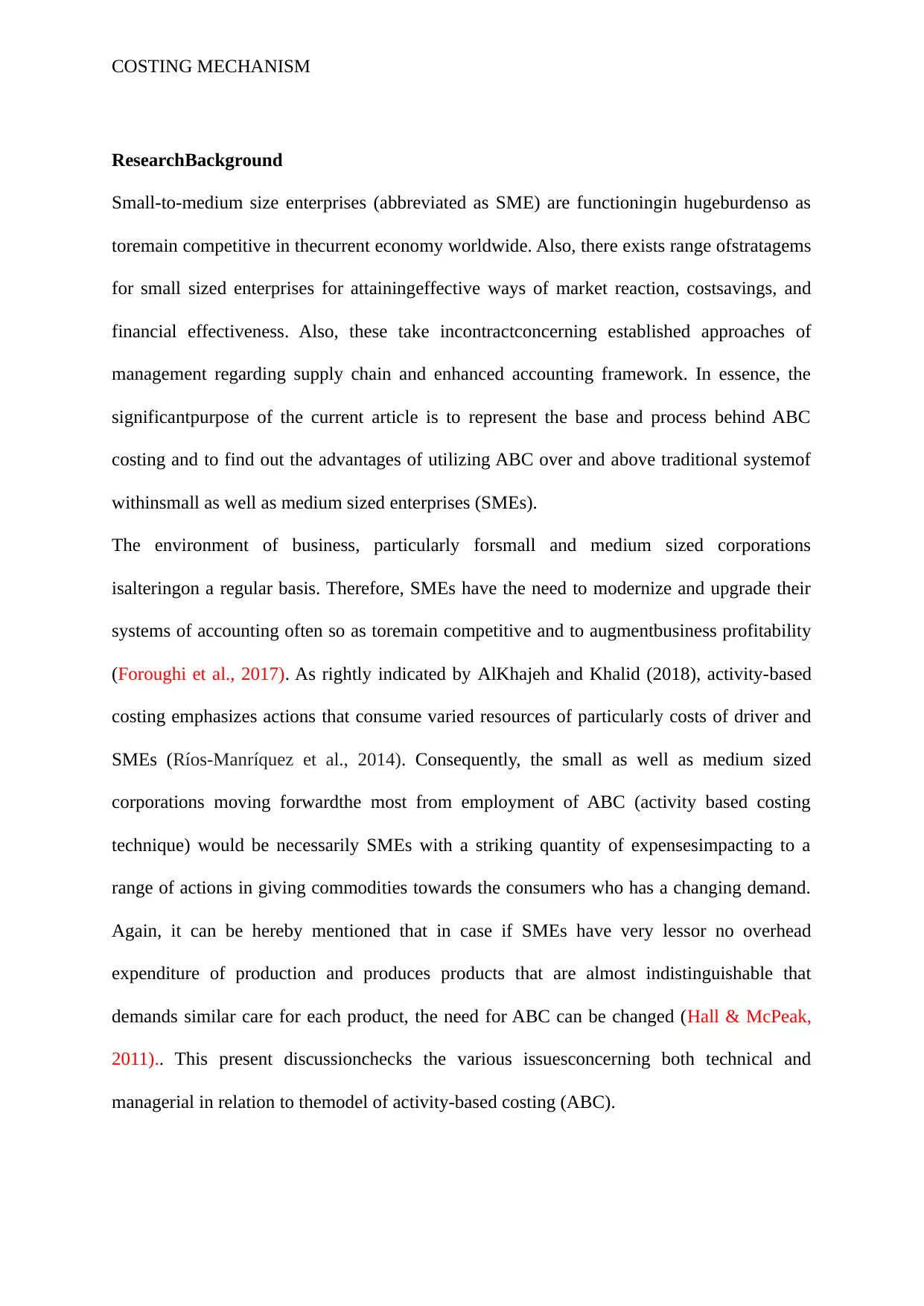
COSTING MECHANISM
ResearchBackground
Small-to-medium size enterprises (abbreviated as SME) are functioningin hugeburdenso as
toremain competitive in thecurrent economy worldwide. Also, there exists range ofstratagems
for small sized enterprises for attainingeffective ways of market reaction, costsavings, and
financial effectiveness. Also, these take incontractconcerning established approaches of
management regarding supply chain and enhanced accounting framework. In essence, the
significantpurpose of the current article is to represent the base and process behind ABC
costing and to find out the advantages of utilizing ABC over and above traditional systemof
withinsmall as well as medium sized enterprises (SMEs).
The environment of business, particularly forsmall and medium sized corporations
isalteringon a regular basis. Therefore, SMEs have the need to modernize and upgrade their
systems of accounting often so as toremain competitive and to augmentbusiness profitability
(Foroughi et al., 2017). As rightly indicated by AlKhajeh and Khalid (2018), activity-based
costing emphasizes actions that consume varied resources of particularly costs of driver and
SMEs (Ríos-Manríquez et al., 2014). Consequently, the small as well as medium sized
corporations moving forwardthe most from employment of ABC (activity based costing
technique) would be necessarily SMEs with a striking quantity of expensesimpacting to a
range of actions in giving commodities towards the consumers who has a changing demand.
Again, it can be hereby mentioned that in case if SMEs have very lessor no overhead
expenditure of production and produces products that are almost indistinguishable that
demands similar care for each product, the need for ABC can be changed (Hall & McPeak,
2011).. This present discussionchecks the various issuesconcerning both technical and
managerial in relation to themodel of activity-based costing (ABC).
ResearchBackground
Small-to-medium size enterprises (abbreviated as SME) are functioningin hugeburdenso as
toremain competitive in thecurrent economy worldwide. Also, there exists range ofstratagems
for small sized enterprises for attainingeffective ways of market reaction, costsavings, and
financial effectiveness. Also, these take incontractconcerning established approaches of
management regarding supply chain and enhanced accounting framework. In essence, the
significantpurpose of the current article is to represent the base and process behind ABC
costing and to find out the advantages of utilizing ABC over and above traditional systemof
withinsmall as well as medium sized enterprises (SMEs).
The environment of business, particularly forsmall and medium sized corporations
isalteringon a regular basis. Therefore, SMEs have the need to modernize and upgrade their
systems of accounting often so as toremain competitive and to augmentbusiness profitability
(Foroughi et al., 2017). As rightly indicated by AlKhajeh and Khalid (2018), activity-based
costing emphasizes actions that consume varied resources of particularly costs of driver and
SMEs (Ríos-Manríquez et al., 2014). Consequently, the small as well as medium sized
corporations moving forwardthe most from employment of ABC (activity based costing
technique) would be necessarily SMEs with a striking quantity of expensesimpacting to a
range of actions in giving commodities towards the consumers who has a changing demand.
Again, it can be hereby mentioned that in case if SMEs have very lessor no overhead
expenditure of production and produces products that are almost indistinguishable that
demands similar care for each product, the need for ABC can be changed (Hall & McPeak,
2011).. This present discussionchecks the various issuesconcerning both technical and
managerial in relation to themodel of activity-based costing (ABC).
⊘ This is a preview!⊘
Do you want full access?
Subscribe today to unlock all pages.

Trusted by 1+ million students worldwide
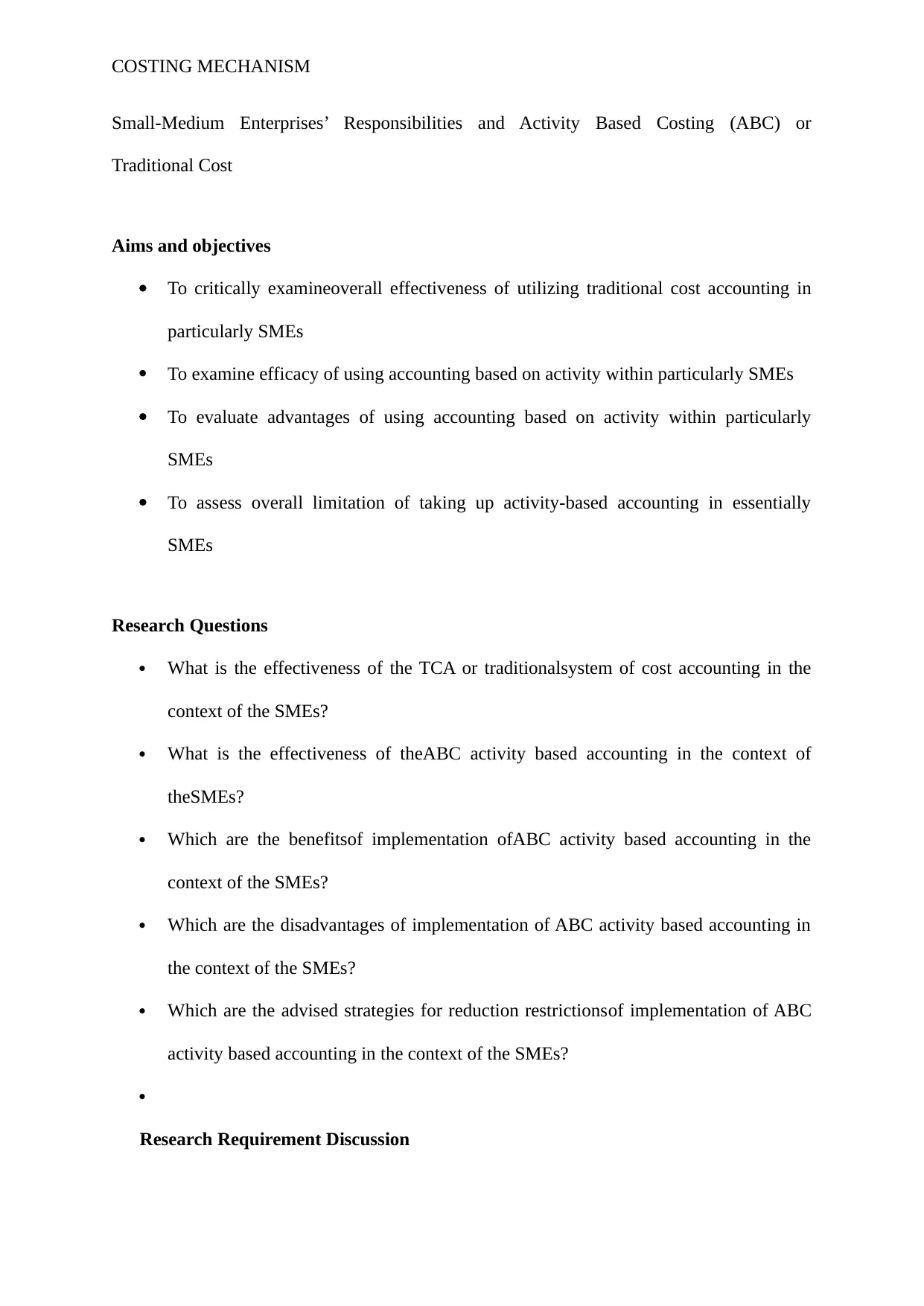
COSTING MECHANISM
Small-Medium Enterprises’ Responsibilities and Activity Based Costing (ABC) or
Traditional Cost
Aims and objectives
To critically examineoverall effectiveness of utilizing traditional cost accounting in
particularly SMEs
To examine efficacy of using accounting based on activity within particularly SMEs
To evaluate advantages of using accounting based on activity within particularly
SMEs
To assess overall limitation of taking up activity-based accounting in essentially
SMEs
Research Questions
What is the effectiveness of the TCA or traditionalsystem of cost accounting in the
context of the SMEs?
What is the effectiveness of theABC activity based accounting in the context of
theSMEs?
Which are the benefitsof implementation ofABC activity based accounting in the
context of the SMEs?
Which are the disadvantages of implementation of ABC activity based accounting in
the context of the SMEs?
Which are the advised strategies for reduction restrictionsof implementation of ABC
activity based accounting in the context of the SMEs?
Research Requirement Discussion
Small-Medium Enterprises’ Responsibilities and Activity Based Costing (ABC) or
Traditional Cost
Aims and objectives
To critically examineoverall effectiveness of utilizing traditional cost accounting in
particularly SMEs
To examine efficacy of using accounting based on activity within particularly SMEs
To evaluate advantages of using accounting based on activity within particularly
SMEs
To assess overall limitation of taking up activity-based accounting in essentially
SMEs
Research Questions
What is the effectiveness of the TCA or traditionalsystem of cost accounting in the
context of the SMEs?
What is the effectiveness of theABC activity based accounting in the context of
theSMEs?
Which are the benefitsof implementation ofABC activity based accounting in the
context of the SMEs?
Which are the disadvantages of implementation of ABC activity based accounting in
the context of the SMEs?
Which are the advised strategies for reduction restrictionsof implementation of ABC
activity based accounting in the context of the SMEs?
Research Requirement Discussion
Paraphrase This Document
Need a fresh take? Get an instant paraphrase of this document with our AI Paraphraser
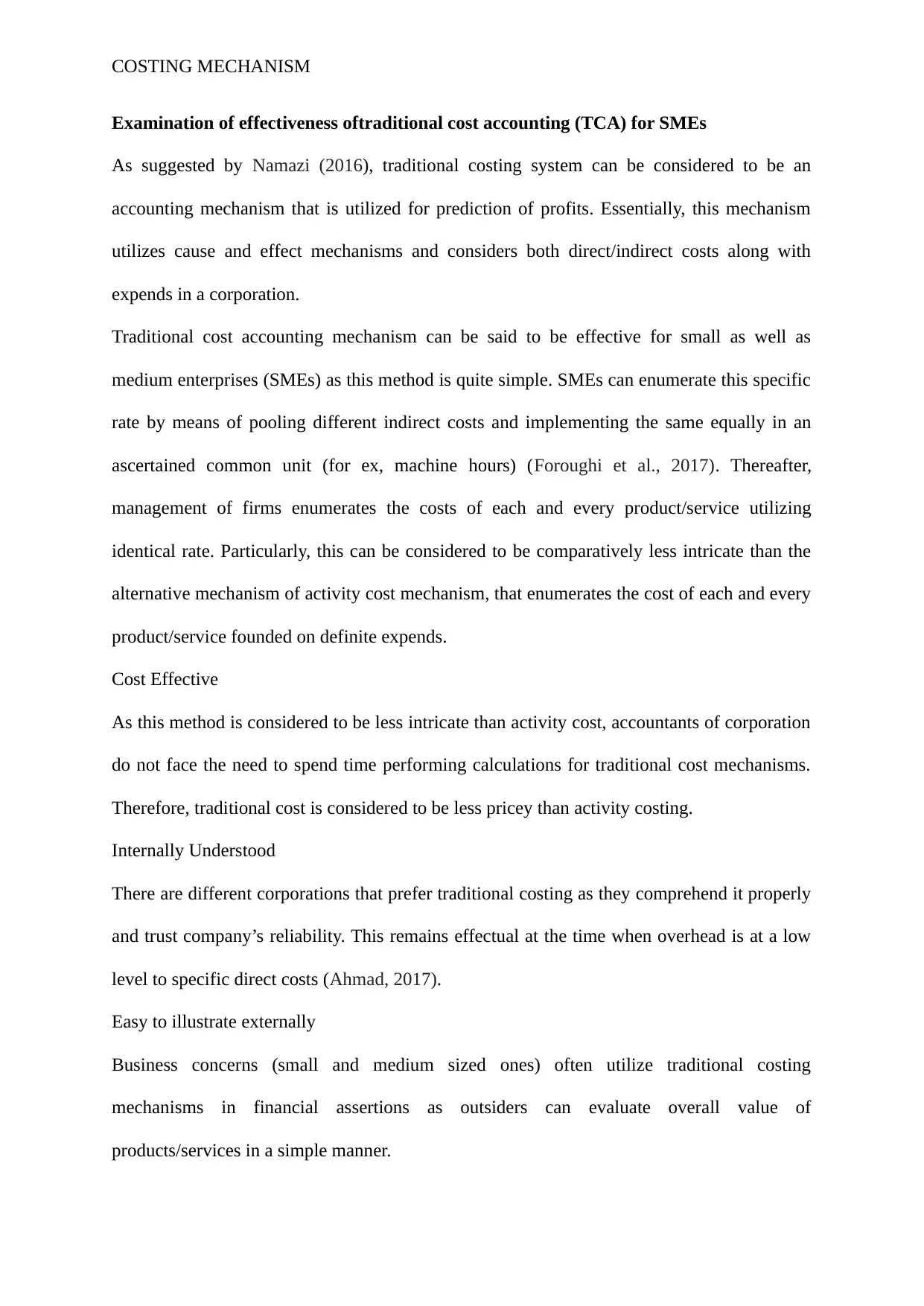
COSTING MECHANISM
Examination of effectiveness oftraditional cost accounting (TCA) for SMEs
As suggested by Namazi (2016), traditional costing system can be considered to be an
accounting mechanism that is utilized for prediction of profits. Essentially, this mechanism
utilizes cause and effect mechanisms and considers both direct/indirect costs along with
expends in a corporation.
Traditional cost accounting mechanism can be said to be effective for small as well as
medium enterprises (SMEs) as this method is quite simple. SMEs can enumerate this specific
rate by means of pooling different indirect costs and implementing the same equally in an
ascertained common unit (for ex, machine hours) (Foroughi et al., 2017). Thereafter,
management of firms enumerates the costs of each and every product/service utilizing
identical rate. Particularly, this can be considered to be comparatively less intricate than the
alternative mechanism of activity cost mechanism, that enumerates the cost of each and every
product/service founded on definite expends.
Cost Effective
As this method is considered to be less intricate than activity cost, accountants of corporation
do not face the need to spend time performing calculations for traditional cost mechanisms.
Therefore, traditional cost is considered to be less pricey than activity costing.
Internally Understood
There are different corporations that prefer traditional costing as they comprehend it properly
and trust company’s reliability. This remains effectual at the time when overhead is at a low
level to specific direct costs (Ahmad, 2017).
Easy to illustrate externally
Business concerns (small and medium sized ones) often utilize traditional costing
mechanisms in financial assertions as outsiders can evaluate overall value of
products/services in a simple manner.
Examination of effectiveness oftraditional cost accounting (TCA) for SMEs
As suggested by Namazi (2016), traditional costing system can be considered to be an
accounting mechanism that is utilized for prediction of profits. Essentially, this mechanism
utilizes cause and effect mechanisms and considers both direct/indirect costs along with
expends in a corporation.
Traditional cost accounting mechanism can be said to be effective for small as well as
medium enterprises (SMEs) as this method is quite simple. SMEs can enumerate this specific
rate by means of pooling different indirect costs and implementing the same equally in an
ascertained common unit (for ex, machine hours) (Foroughi et al., 2017). Thereafter,
management of firms enumerates the costs of each and every product/service utilizing
identical rate. Particularly, this can be considered to be comparatively less intricate than the
alternative mechanism of activity cost mechanism, that enumerates the cost of each and every
product/service founded on definite expends.
Cost Effective
As this method is considered to be less intricate than activity cost, accountants of corporation
do not face the need to spend time performing calculations for traditional cost mechanisms.
Therefore, traditional cost is considered to be less pricey than activity costing.
Internally Understood
There are different corporations that prefer traditional costing as they comprehend it properly
and trust company’s reliability. This remains effectual at the time when overhead is at a low
level to specific direct costs (Ahmad, 2017).
Easy to illustrate externally
Business concerns (small and medium sized ones) often utilize traditional costing
mechanisms in financial assertions as outsiders can evaluate overall value of
products/services in a simple manner.
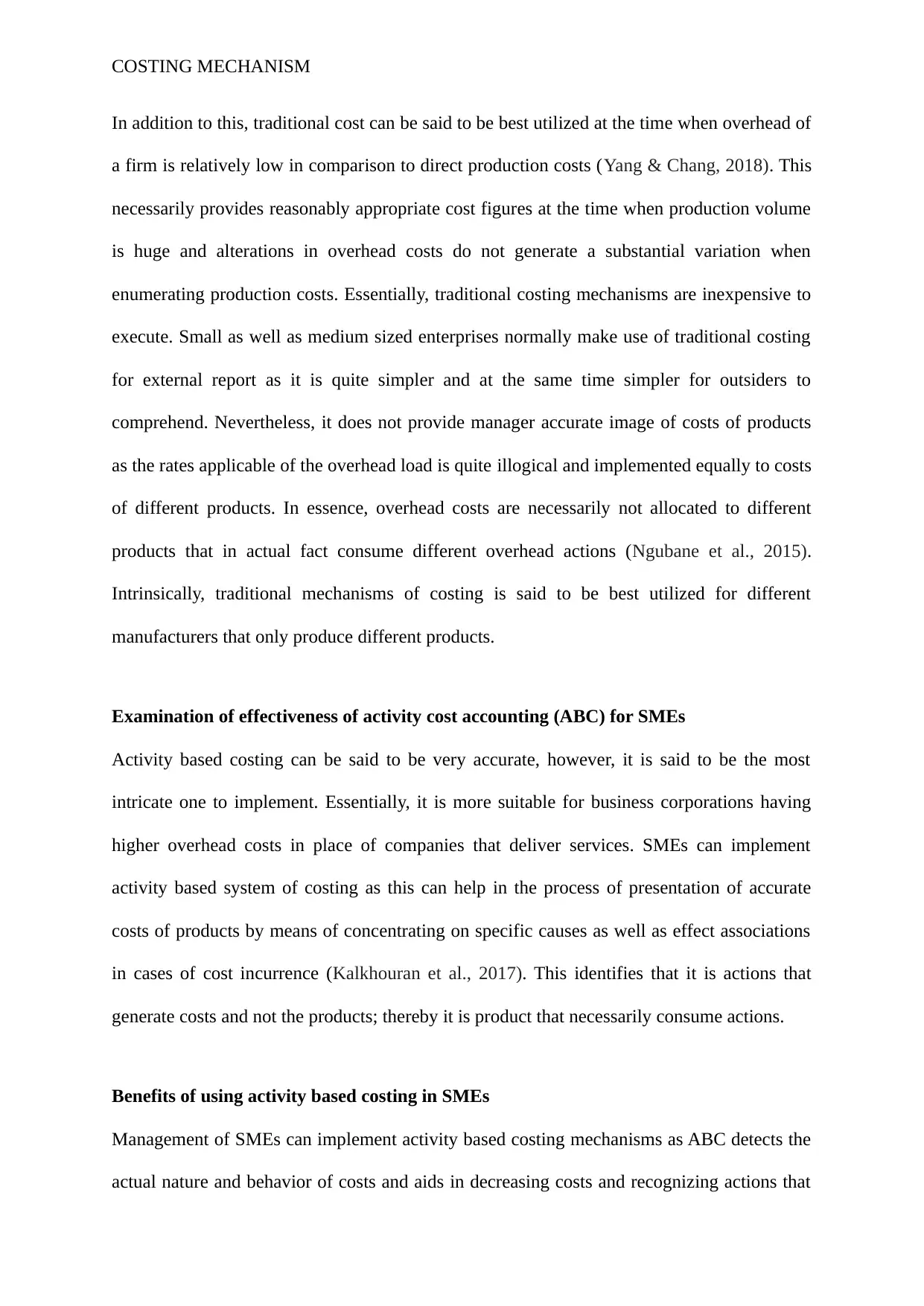
COSTING MECHANISM
In addition to this, traditional cost can be said to be best utilized at the time when overhead of
a firm is relatively low in comparison to direct production costs (Yang & Chang, 2018). This
necessarily provides reasonably appropriate cost figures at the time when production volume
is huge and alterations in overhead costs do not generate a substantial variation when
enumerating production costs. Essentially, traditional costing mechanisms are inexpensive to
execute. Small as well as medium sized enterprises normally make use of traditional costing
for external report as it is quite simpler and at the same time simpler for outsiders to
comprehend. Nevertheless, it does not provide manager accurate image of costs of products
as the rates applicable of the overhead load is quite illogical and implemented equally to costs
of different products. In essence, overhead costs are necessarily not allocated to different
products that in actual fact consume different overhead actions (Ngubane et al., 2015).
Intrinsically, traditional mechanisms of costing is said to be best utilized for different
manufacturers that only produce different products.
Examination of effectiveness of activity cost accounting (ABC) for SMEs
Activity based costing can be said to be very accurate, however, it is said to be the most
intricate one to implement. Essentially, it is more suitable for business corporations having
higher overhead costs in place of companies that deliver services. SMEs can implement
activity based system of costing as this can help in the process of presentation of accurate
costs of products by means of concentrating on specific causes as well as effect associations
in cases of cost incurrence (Kalkhouran et al., 2017). This identifies that it is actions that
generate costs and not the products; thereby it is product that necessarily consume actions.
Benefits of using activity based costing in SMEs
Management of SMEs can implement activity based costing mechanisms as ABC detects the
actual nature and behavior of costs and aids in decreasing costs and recognizing actions that
In addition to this, traditional cost can be said to be best utilized at the time when overhead of
a firm is relatively low in comparison to direct production costs (Yang & Chang, 2018). This
necessarily provides reasonably appropriate cost figures at the time when production volume
is huge and alterations in overhead costs do not generate a substantial variation when
enumerating production costs. Essentially, traditional costing mechanisms are inexpensive to
execute. Small as well as medium sized enterprises normally make use of traditional costing
for external report as it is quite simpler and at the same time simpler for outsiders to
comprehend. Nevertheless, it does not provide manager accurate image of costs of products
as the rates applicable of the overhead load is quite illogical and implemented equally to costs
of different products. In essence, overhead costs are necessarily not allocated to different
products that in actual fact consume different overhead actions (Ngubane et al., 2015).
Intrinsically, traditional mechanisms of costing is said to be best utilized for different
manufacturers that only produce different products.
Examination of effectiveness of activity cost accounting (ABC) for SMEs
Activity based costing can be said to be very accurate, however, it is said to be the most
intricate one to implement. Essentially, it is more suitable for business corporations having
higher overhead costs in place of companies that deliver services. SMEs can implement
activity based system of costing as this can help in the process of presentation of accurate
costs of products by means of concentrating on specific causes as well as effect associations
in cases of cost incurrence (Kalkhouran et al., 2017). This identifies that it is actions that
generate costs and not the products; thereby it is product that necessarily consume actions.
Benefits of using activity based costing in SMEs
Management of SMEs can implement activity based costing mechanisms as ABC detects the
actual nature and behavior of costs and aids in decreasing costs and recognizing actions that
⊘ This is a preview!⊘
Do you want full access?
Subscribe today to unlock all pages.

Trusted by 1+ million students worldwide
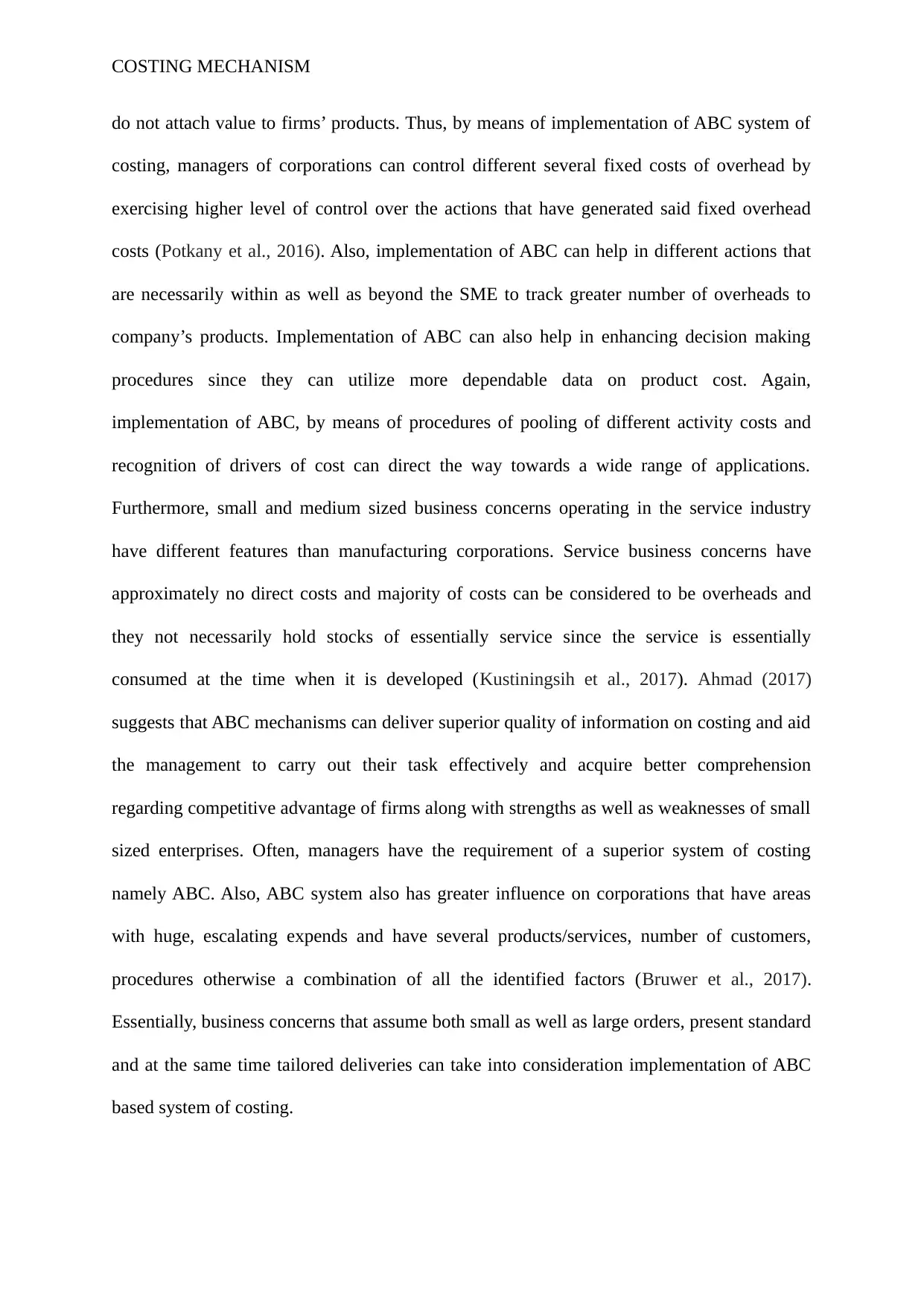
COSTING MECHANISM
do not attach value to firms’ products. Thus, by means of implementation of ABC system of
costing, managers of corporations can control different several fixed costs of overhead by
exercising higher level of control over the actions that have generated said fixed overhead
costs (Potkany et al., 2016). Also, implementation of ABC can help in different actions that
are necessarily within as well as beyond the SME to track greater number of overheads to
company’s products. Implementation of ABC can also help in enhancing decision making
procedures since they can utilize more dependable data on product cost. Again,
implementation of ABC, by means of procedures of pooling of different activity costs and
recognition of drivers of cost can direct the way towards a wide range of applications.
Furthermore, small and medium sized business concerns operating in the service industry
have different features than manufacturing corporations. Service business concerns have
approximately no direct costs and majority of costs can be considered to be overheads and
they not necessarily hold stocks of essentially service since the service is essentially
consumed at the time when it is developed (Kustiningsih et al., 2017). Ahmad (2017)
suggests that ABC mechanisms can deliver superior quality of information on costing and aid
the management to carry out their task effectively and acquire better comprehension
regarding competitive advantage of firms along with strengths as well as weaknesses of small
sized enterprises. Often, managers have the requirement of a superior system of costing
namely ABC. Also, ABC system also has greater influence on corporations that have areas
with huge, escalating expends and have several products/services, number of customers,
procedures otherwise a combination of all the identified factors (Bruwer et al., 2017).
Essentially, business concerns that assume both small as well as large orders, present standard
and at the same time tailored deliveries can take into consideration implementation of ABC
based system of costing.
do not attach value to firms’ products. Thus, by means of implementation of ABC system of
costing, managers of corporations can control different several fixed costs of overhead by
exercising higher level of control over the actions that have generated said fixed overhead
costs (Potkany et al., 2016). Also, implementation of ABC can help in different actions that
are necessarily within as well as beyond the SME to track greater number of overheads to
company’s products. Implementation of ABC can also help in enhancing decision making
procedures since they can utilize more dependable data on product cost. Again,
implementation of ABC, by means of procedures of pooling of different activity costs and
recognition of drivers of cost can direct the way towards a wide range of applications.
Furthermore, small and medium sized business concerns operating in the service industry
have different features than manufacturing corporations. Service business concerns have
approximately no direct costs and majority of costs can be considered to be overheads and
they not necessarily hold stocks of essentially service since the service is essentially
consumed at the time when it is developed (Kustiningsih et al., 2017). Ahmad (2017)
suggests that ABC mechanisms can deliver superior quality of information on costing and aid
the management to carry out their task effectively and acquire better comprehension
regarding competitive advantage of firms along with strengths as well as weaknesses of small
sized enterprises. Often, managers have the requirement of a superior system of costing
namely ABC. Also, ABC system also has greater influence on corporations that have areas
with huge, escalating expends and have several products/services, number of customers,
procedures otherwise a combination of all the identified factors (Bruwer et al., 2017).
Essentially, business concerns that assume both small as well as large orders, present standard
and at the same time tailored deliveries can take into consideration implementation of ABC
based system of costing.
Paraphrase This Document
Need a fresh take? Get an instant paraphrase of this document with our AI Paraphraser
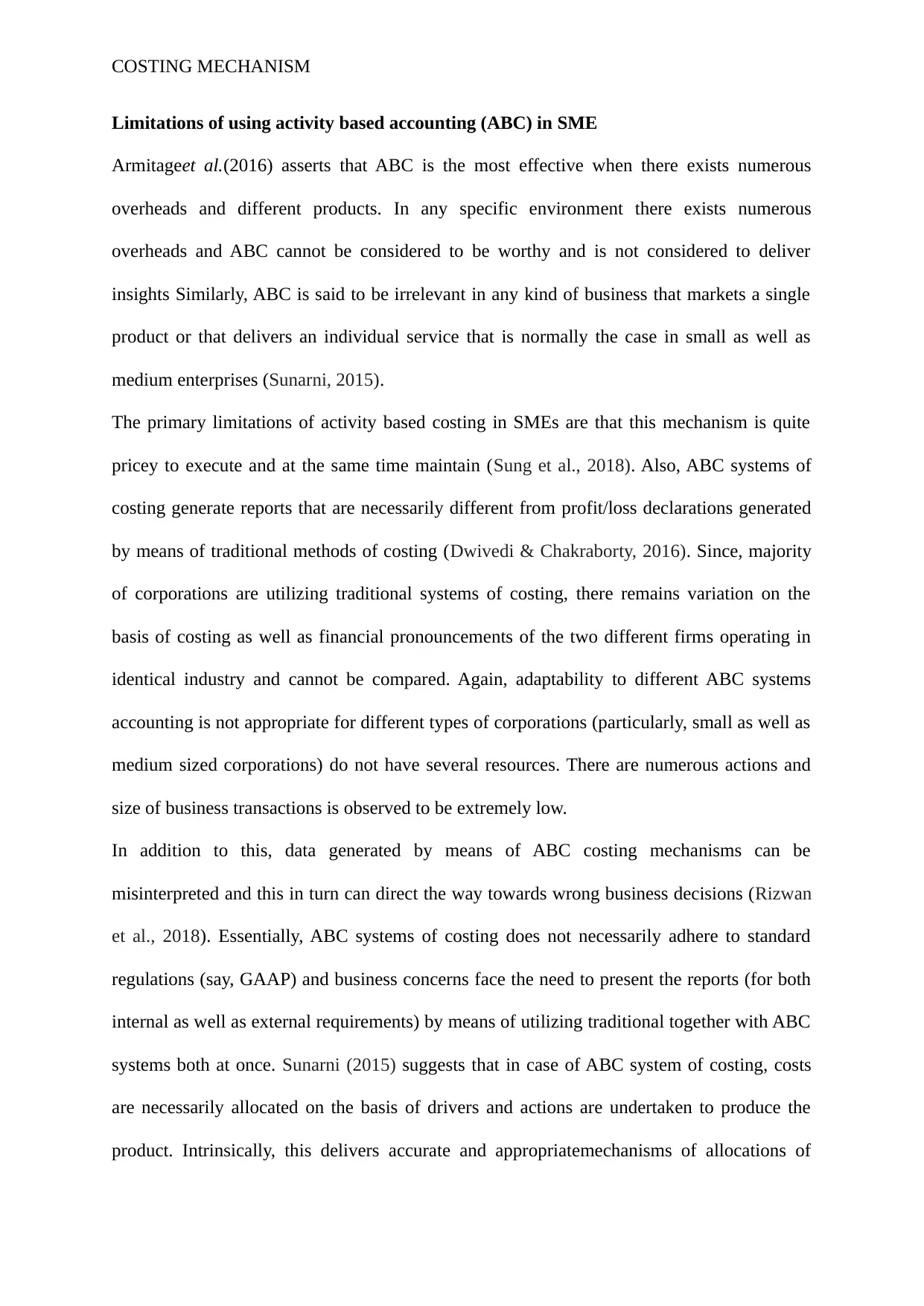
COSTING MECHANISM
Limitations of using activity based accounting (ABC) in SME
Armitageet al.(2016) asserts that ABC is the most effective when there exists numerous
overheads and different products. In any specific environment there exists numerous
overheads and ABC cannot be considered to be worthy and is not considered to deliver
insights Similarly, ABC is said to be irrelevant in any kind of business that markets a single
product or that delivers an individual service that is normally the case in small as well as
medium enterprises (Sunarni, 2015).
The primary limitations of activity based costing in SMEs are that this mechanism is quite
pricey to execute and at the same time maintain (Sung et al., 2018). Also, ABC systems of
costing generate reports that are necessarily different from profit/loss declarations generated
by means of traditional methods of costing (Dwivedi & Chakraborty, 2016). Since, majority
of corporations are utilizing traditional systems of costing, there remains variation on the
basis of costing as well as financial pronouncements of the two different firms operating in
identical industry and cannot be compared. Again, adaptability to different ABC systems
accounting is not appropriate for different types of corporations (particularly, small as well as
medium sized corporations) do not have several resources. There are numerous actions and
size of business transactions is observed to be extremely low.
In addition to this, data generated by means of ABC costing mechanisms can be
misinterpreted and this in turn can direct the way towards wrong business decisions (Rizwan
et al., 2018). Essentially, ABC systems of costing does not necessarily adhere to standard
regulations (say, GAAP) and business concerns face the need to present the reports (for both
internal as well as external requirements) by means of utilizing traditional together with ABC
systems both at once. Sunarni (2015) suggests that in case of ABC system of costing, costs
are necessarily allocated on the basis of drivers and actions are undertaken to produce the
product. Intrinsically, this delivers accurate and appropriatemechanisms of allocations of
Limitations of using activity based accounting (ABC) in SME
Armitageet al.(2016) asserts that ABC is the most effective when there exists numerous
overheads and different products. In any specific environment there exists numerous
overheads and ABC cannot be considered to be worthy and is not considered to deliver
insights Similarly, ABC is said to be irrelevant in any kind of business that markets a single
product or that delivers an individual service that is normally the case in small as well as
medium enterprises (Sunarni, 2015).
The primary limitations of activity based costing in SMEs are that this mechanism is quite
pricey to execute and at the same time maintain (Sung et al., 2018). Also, ABC systems of
costing generate reports that are necessarily different from profit/loss declarations generated
by means of traditional methods of costing (Dwivedi & Chakraborty, 2016). Since, majority
of corporations are utilizing traditional systems of costing, there remains variation on the
basis of costing as well as financial pronouncements of the two different firms operating in
identical industry and cannot be compared. Again, adaptability to different ABC systems
accounting is not appropriate for different types of corporations (particularly, small as well as
medium sized corporations) do not have several resources. There are numerous actions and
size of business transactions is observed to be extremely low.
In addition to this, data generated by means of ABC costing mechanisms can be
misinterpreted and this in turn can direct the way towards wrong business decisions (Rizwan
et al., 2018). Essentially, ABC systems of costing does not necessarily adhere to standard
regulations (say, GAAP) and business concerns face the need to present the reports (for both
internal as well as external requirements) by means of utilizing traditional together with ABC
systems both at once. Sunarni (2015) suggests that in case of ABC system of costing, costs
are necessarily allocated on the basis of drivers and actions are undertaken to produce the
product. Intrinsically, this delivers accurate and appropriatemechanisms of allocations of
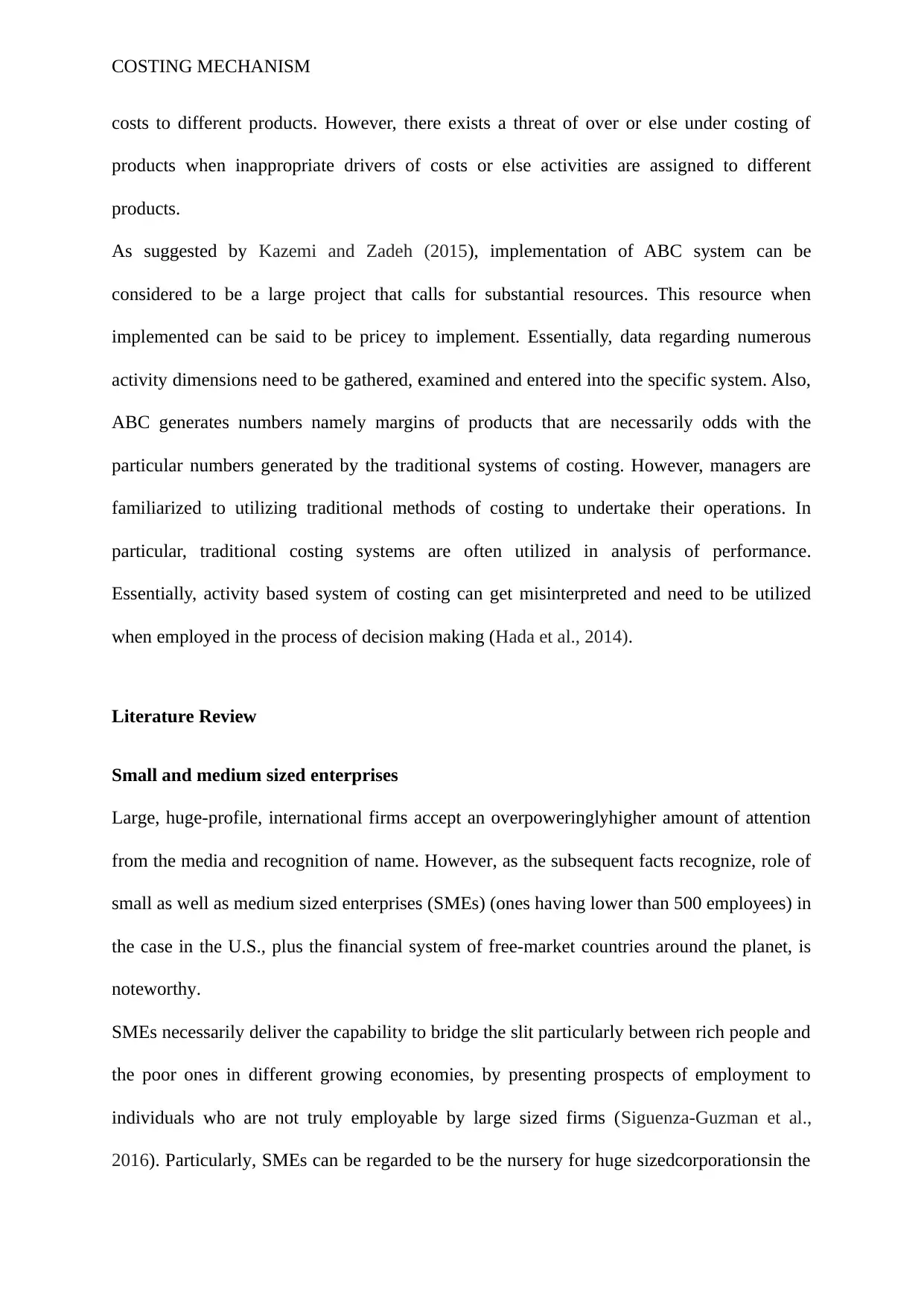
COSTING MECHANISM
costs to different products. However, there exists a threat of over or else under costing of
products when inappropriate drivers of costs or else activities are assigned to different
products.
As suggested by Kazemi and Zadeh (2015), implementation of ABC system can be
considered to be a large project that calls for substantial resources. This resource when
implemented can be said to be pricey to implement. Essentially, data regarding numerous
activity dimensions need to be gathered, examined and entered into the specific system. Also,
ABC generates numbers namely margins of products that are necessarily odds with the
particular numbers generated by the traditional systems of costing. However, managers are
familiarized to utilizing traditional methods of costing to undertake their operations. In
particular, traditional costing systems are often utilized in analysis of performance.
Essentially, activity based system of costing can get misinterpreted and need to be utilized
when employed in the process of decision making (Hada et al., 2014).
Literature Review
Small and medium sized enterprises
Large, huge-profile, international firms accept an overpoweringlyhigher amount of attention
from the media and recognition of name. However, as the subsequent facts recognize, role of
small as well as medium sized enterprises (SMEs) (ones having lower than 500 employees) in
the case in the U.S., plus the financial system of free-market countries around the planet, is
noteworthy.
SMEs necessarily deliver the capability to bridge the slit particularly between rich people and
the poor ones in different growing economies, by presenting prospects of employment to
individuals who are not truly employable by large sized firms (Siguenza-Guzman et al.,
2016). Particularly, SMEs can be regarded to be the nursery for huge sizedcorporationsin the
costs to different products. However, there exists a threat of over or else under costing of
products when inappropriate drivers of costs or else activities are assigned to different
products.
As suggested by Kazemi and Zadeh (2015), implementation of ABC system can be
considered to be a large project that calls for substantial resources. This resource when
implemented can be said to be pricey to implement. Essentially, data regarding numerous
activity dimensions need to be gathered, examined and entered into the specific system. Also,
ABC generates numbers namely margins of products that are necessarily odds with the
particular numbers generated by the traditional systems of costing. However, managers are
familiarized to utilizing traditional methods of costing to undertake their operations. In
particular, traditional costing systems are often utilized in analysis of performance.
Essentially, activity based system of costing can get misinterpreted and need to be utilized
when employed in the process of decision making (Hada et al., 2014).
Literature Review
Small and medium sized enterprises
Large, huge-profile, international firms accept an overpoweringlyhigher amount of attention
from the media and recognition of name. However, as the subsequent facts recognize, role of
small as well as medium sized enterprises (SMEs) (ones having lower than 500 employees) in
the case in the U.S., plus the financial system of free-market countries around the planet, is
noteworthy.
SMEs necessarily deliver the capability to bridge the slit particularly between rich people and
the poor ones in different growing economies, by presenting prospects of employment to
individuals who are not truly employable by large sized firms (Siguenza-Guzman et al.,
2016). Particularly, SMEs can be regarded to be the nursery for huge sizedcorporationsin the
⊘ This is a preview!⊘
Do you want full access?
Subscribe today to unlock all pages.

Trusted by 1+ million students worldwide
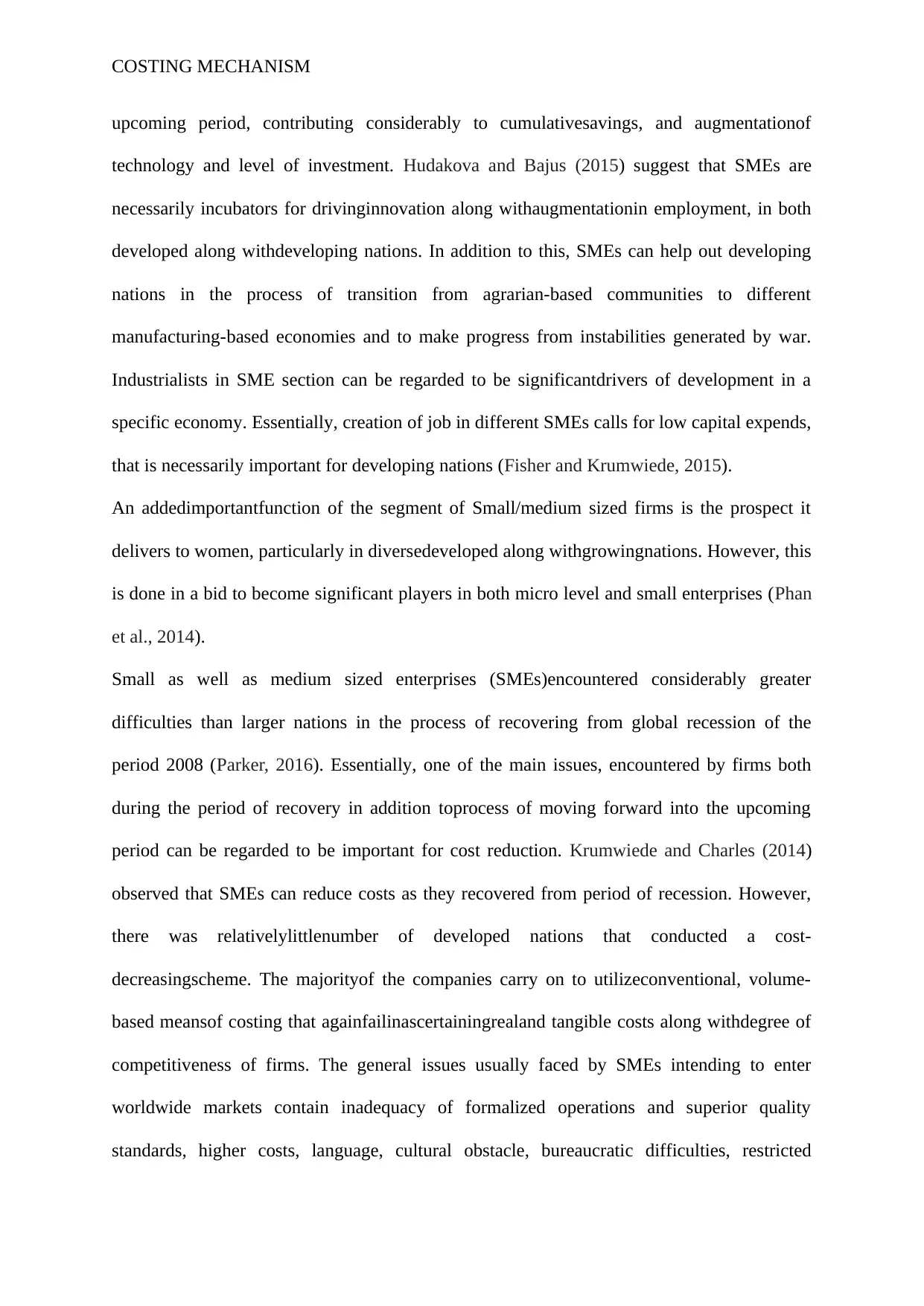
COSTING MECHANISM
upcoming period, contributing considerably to cumulativesavings, and augmentationof
technology and level of investment. Hudakova and Bajus (2015) suggest that SMEs are
necessarily incubators for drivinginnovation along withaugmentationin employment, in both
developed along withdeveloping nations. In addition to this, SMEs can help out developing
nations in the process of transition from agrarian-based communities to different
manufacturing-based economies and to make progress from instabilities generated by war.
Industrialists in SME section can be regarded to be significantdrivers of development in a
specific economy. Essentially, creation of job in different SMEs calls for low capital expends,
that is necessarily important for developing nations (Fisher and Krumwiede, 2015).
An addedimportantfunction of the segment of Small/medium sized firms is the prospect it
delivers to women, particularly in diversedeveloped along withgrowingnations. However, this
is done in a bid to become significant players in both micro level and small enterprises (Phan
et al., 2014).
Small as well as medium sized enterprises (SMEs)encountered considerably greater
difficulties than larger nations in the process of recovering from global recession of the
period 2008 (Parker, 2016). Essentially, one of the main issues, encountered by firms both
during the period of recovery in addition toprocess of moving forward into the upcoming
period can be regarded to be important for cost reduction. Krumwiede and Charles (2014)
observed that SMEs can reduce costs as they recovered from period of recession. However,
there was relativelylittlenumber of developed nations that conducted a cost-
decreasingscheme. The majorityof the companies carry on to utilizeconventional, volume-
based meansof costing that againfailinascertainingrealand tangible costs along withdegree of
competitiveness of firms. The general issues usually faced by SMEs intending to enter
worldwide markets contain inadequacy of formalized operations and superior quality
standards, higher costs, language, cultural obstacle, bureaucratic difficulties, restricted
upcoming period, contributing considerably to cumulativesavings, and augmentationof
technology and level of investment. Hudakova and Bajus (2015) suggest that SMEs are
necessarily incubators for drivinginnovation along withaugmentationin employment, in both
developed along withdeveloping nations. In addition to this, SMEs can help out developing
nations in the process of transition from agrarian-based communities to different
manufacturing-based economies and to make progress from instabilities generated by war.
Industrialists in SME section can be regarded to be significantdrivers of development in a
specific economy. Essentially, creation of job in different SMEs calls for low capital expends,
that is necessarily important for developing nations (Fisher and Krumwiede, 2015).
An addedimportantfunction of the segment of Small/medium sized firms is the prospect it
delivers to women, particularly in diversedeveloped along withgrowingnations. However, this
is done in a bid to become significant players in both micro level and small enterprises (Phan
et al., 2014).
Small as well as medium sized enterprises (SMEs)encountered considerably greater
difficulties than larger nations in the process of recovering from global recession of the
period 2008 (Parker, 2016). Essentially, one of the main issues, encountered by firms both
during the period of recovery in addition toprocess of moving forward into the upcoming
period can be regarded to be important for cost reduction. Krumwiede and Charles (2014)
observed that SMEs can reduce costs as they recovered from period of recession. However,
there was relativelylittlenumber of developed nations that conducted a cost-
decreasingscheme. The majorityof the companies carry on to utilizeconventional, volume-
based meansof costing that againfailinascertainingrealand tangible costs along withdegree of
competitiveness of firms. The general issues usually faced by SMEs intending to enter
worldwide markets contain inadequacy of formalized operations and superior quality
standards, higher costs, language, cultural obstacle, bureaucratic difficulties, restricted
Paraphrase This Document
Need a fresh take? Get an instant paraphrase of this document with our AI Paraphraser
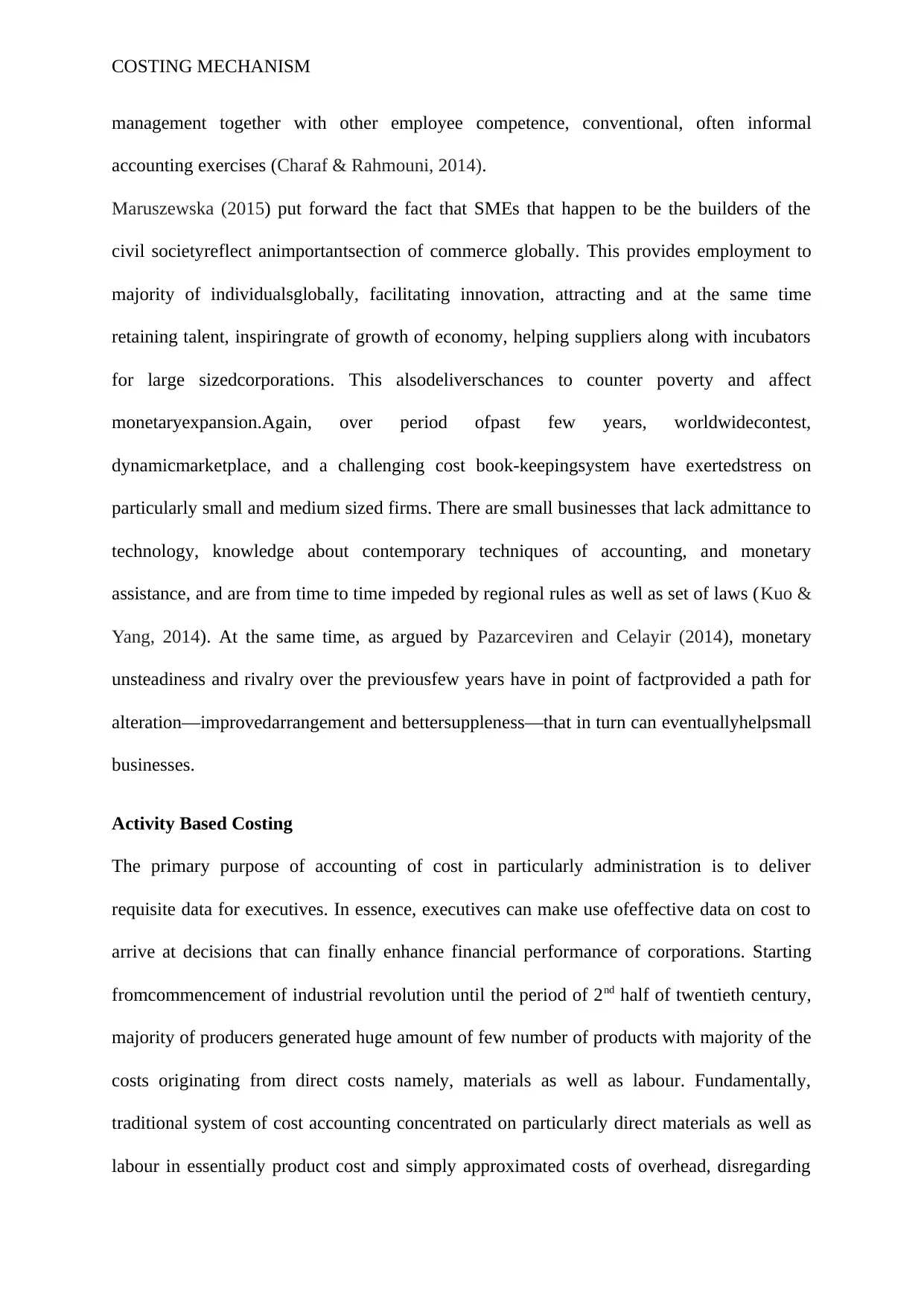
COSTING MECHANISM
management together with other employee competence, conventional, often informal
accounting exercises (Charaf & Rahmouni, 2014).
Maruszewska (2015) put forward the fact that SMEs that happen to be the builders of the
civil societyreflect animportantsection of commerce globally. This provides employment to
majority of individualsglobally, facilitating innovation, attracting and at the same time
retaining talent, inspiringrate of growth of economy, helping suppliers along with incubators
for large sizedcorporations. This alsodeliverschances to counter poverty and affect
monetaryexpansion.Again, over period ofpast few years, worldwidecontest,
dynamicmarketplace, and a challenging cost book-keepingsystem have exertedstress on
particularly small and medium sized firms. There are small businesses that lack admittance to
technology, knowledge about contemporary techniques of accounting, and monetary
assistance, and are from time to time impeded by regional rules as well as set of laws (Kuo &
Yang, 2014). At the same time, as argued by Pazarceviren and Celayir (2014), monetary
unsteadiness and rivalry over the previousfew years have in point of factprovided a path for
alteration—improvedarrangement and bettersuppleness—that in turn can eventuallyhelpsmall
businesses.
Activity Based Costing
The primary purpose of accounting of cost in particularly administration is to deliver
requisite data for executives. In essence, executives can make use ofeffective data on cost to
arrive at decisions that can finally enhance financial performance of corporations. Starting
fromcommencement of industrial revolution until the period of 2nd half of twentieth century,
majority of producers generated huge amount of few number of products with majority of the
costs originating from direct costs namely, materials as well as labour. Fundamentally,
traditional system of cost accounting concentrated on particularly direct materials as well as
labour in essentially product cost and simply approximated costs of overhead, disregarding
management together with other employee competence, conventional, often informal
accounting exercises (Charaf & Rahmouni, 2014).
Maruszewska (2015) put forward the fact that SMEs that happen to be the builders of the
civil societyreflect animportantsection of commerce globally. This provides employment to
majority of individualsglobally, facilitating innovation, attracting and at the same time
retaining talent, inspiringrate of growth of economy, helping suppliers along with incubators
for large sizedcorporations. This alsodeliverschances to counter poverty and affect
monetaryexpansion.Again, over period ofpast few years, worldwidecontest,
dynamicmarketplace, and a challenging cost book-keepingsystem have exertedstress on
particularly small and medium sized firms. There are small businesses that lack admittance to
technology, knowledge about contemporary techniques of accounting, and monetary
assistance, and are from time to time impeded by regional rules as well as set of laws (Kuo &
Yang, 2014). At the same time, as argued by Pazarceviren and Celayir (2014), monetary
unsteadiness and rivalry over the previousfew years have in point of factprovided a path for
alteration—improvedarrangement and bettersuppleness—that in turn can eventuallyhelpsmall
businesses.
Activity Based Costing
The primary purpose of accounting of cost in particularly administration is to deliver
requisite data for executives. In essence, executives can make use ofeffective data on cost to
arrive at decisions that can finally enhance financial performance of corporations. Starting
fromcommencement of industrial revolution until the period of 2nd half of twentieth century,
majority of producers generated huge amount of few number of products with majority of the
costs originating from direct costs namely, materials as well as labour. Fundamentally,
traditional system of cost accounting concentrated on particularly direct materials as well as
labour in essentially product cost and simply approximated costs of overhead, disregarding
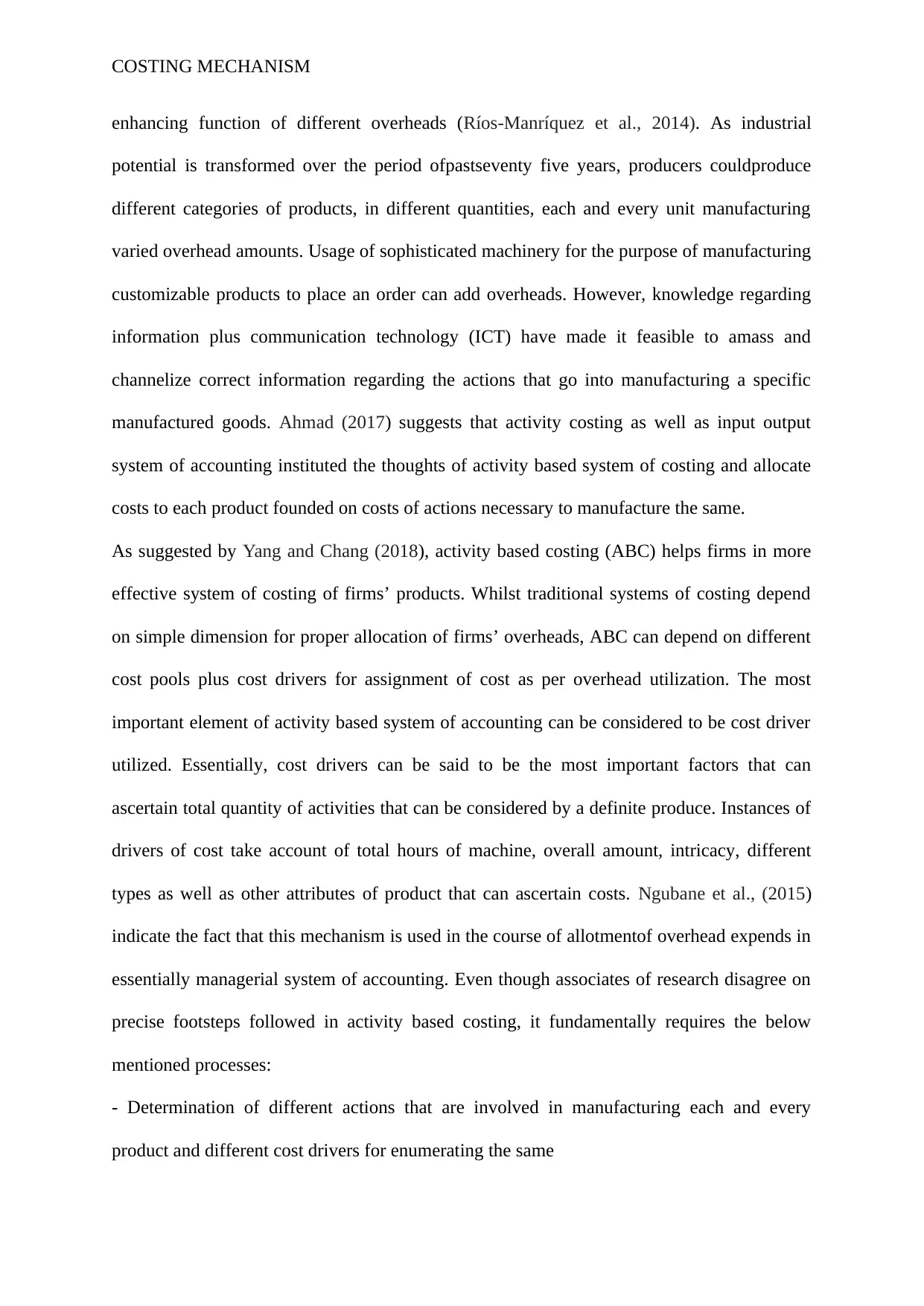
COSTING MECHANISM
enhancing function of different overheads (Ríos-Manríquez et al., 2014). As industrial
potential is transformed over the period ofpastseventy five years, producers couldproduce
different categories of products, in different quantities, each and every unit manufacturing
varied overhead amounts. Usage of sophisticated machinery for the purpose of manufacturing
customizable products to place an order can add overheads. However, knowledge regarding
information plus communication technology (ICT) have made it feasible to amass and
channelize correct information regarding the actions that go into manufacturing a specific
manufactured goods. Ahmad (2017) suggests that activity costing as well as input output
system of accounting instituted the thoughts of activity based system of costing and allocate
costs to each product founded on costs of actions necessary to manufacture the same.
As suggested by Yang and Chang (2018), activity based costing (ABC) helps firms in more
effective system of costing of firms’ products. Whilst traditional systems of costing depend
on simple dimension for proper allocation of firms’ overheads, ABC can depend on different
cost pools plus cost drivers for assignment of cost as per overhead utilization. The most
important element of activity based system of accounting can be considered to be cost driver
utilized. Essentially, cost drivers can be said to be the most important factors that can
ascertain total quantity of activities that can be considered by a definite produce. Instances of
drivers of cost take account of total hours of machine, overall amount, intricacy, different
types as well as other attributes of product that can ascertain costs. Ngubane et al., (2015)
indicate the fact that this mechanism is used in the course of allotmentof overhead expends in
essentially managerial system of accounting. Even though associates of research disagree on
precise footsteps followed in activity based costing, it fundamentally requires the below
mentioned processes:
- Determination of different actions that are involved in manufacturing each and every
product and different cost drivers for enumerating the same
enhancing function of different overheads (Ríos-Manríquez et al., 2014). As industrial
potential is transformed over the period ofpastseventy five years, producers couldproduce
different categories of products, in different quantities, each and every unit manufacturing
varied overhead amounts. Usage of sophisticated machinery for the purpose of manufacturing
customizable products to place an order can add overheads. However, knowledge regarding
information plus communication technology (ICT) have made it feasible to amass and
channelize correct information regarding the actions that go into manufacturing a specific
manufactured goods. Ahmad (2017) suggests that activity costing as well as input output
system of accounting instituted the thoughts of activity based system of costing and allocate
costs to each product founded on costs of actions necessary to manufacture the same.
As suggested by Yang and Chang (2018), activity based costing (ABC) helps firms in more
effective system of costing of firms’ products. Whilst traditional systems of costing depend
on simple dimension for proper allocation of firms’ overheads, ABC can depend on different
cost pools plus cost drivers for assignment of cost as per overhead utilization. The most
important element of activity based system of accounting can be considered to be cost driver
utilized. Essentially, cost drivers can be said to be the most important factors that can
ascertain total quantity of activities that can be considered by a definite produce. Instances of
drivers of cost take account of total hours of machine, overall amount, intricacy, different
types as well as other attributes of product that can ascertain costs. Ngubane et al., (2015)
indicate the fact that this mechanism is used in the course of allotmentof overhead expends in
essentially managerial system of accounting. Even though associates of research disagree on
precise footsteps followed in activity based costing, it fundamentally requires the below
mentioned processes:
- Determination of different actions that are involved in manufacturing each and every
product and different cost drivers for enumerating the same
⊘ This is a preview!⊘
Do you want full access?
Subscribe today to unlock all pages.

Trusted by 1+ million students worldwide
1 out of 34
Related Documents
Your All-in-One AI-Powered Toolkit for Academic Success.
+13062052269
info@desklib.com
Available 24*7 on WhatsApp / Email
![[object Object]](/_next/static/media/star-bottom.7253800d.svg)
Unlock your academic potential
Copyright © 2020–2025 A2Z Services. All Rights Reserved. Developed and managed by ZUCOL.





